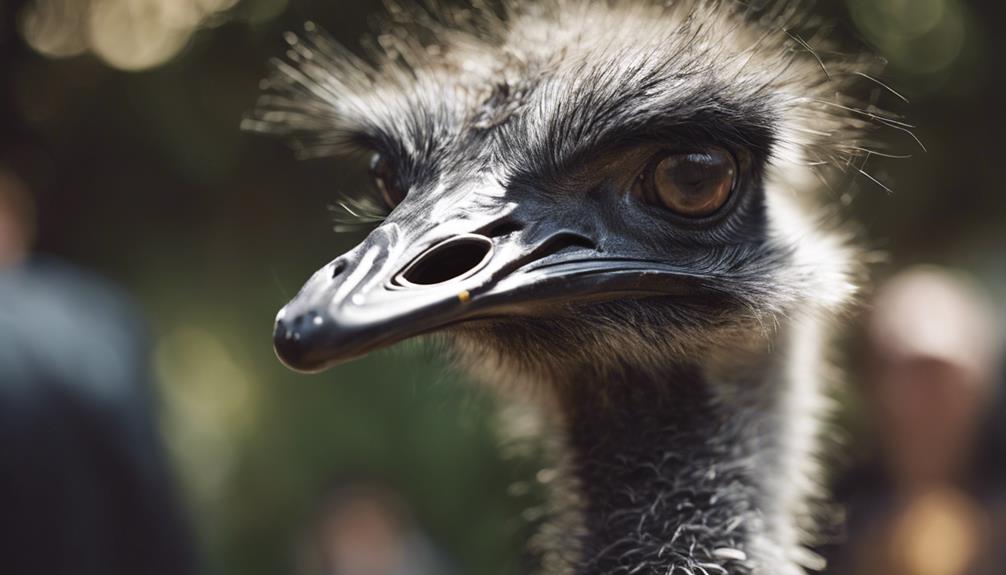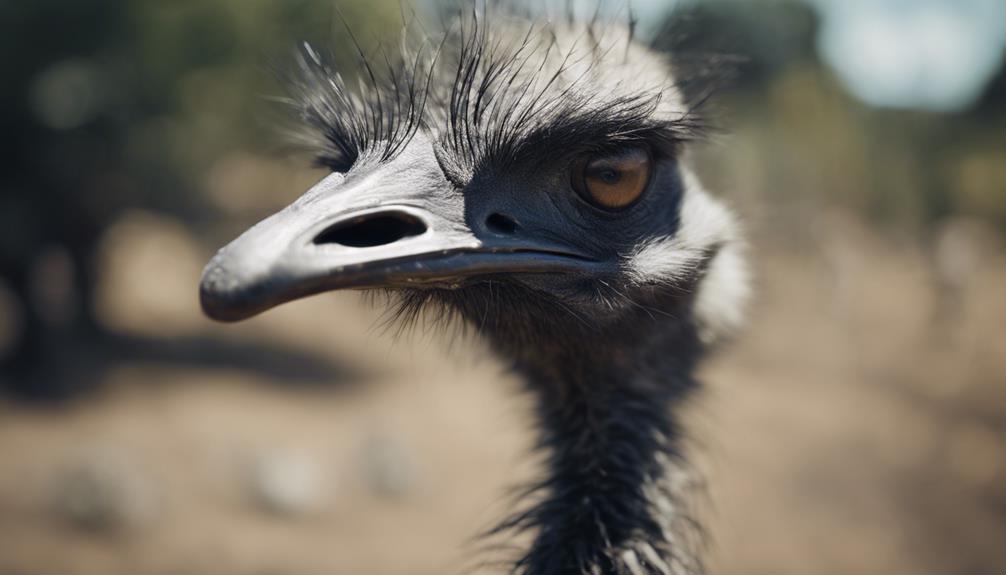
Did you know that emus can suffer from diseases like candidiasis and necrotic enteritis? Understanding the signs and preventive measures for these ailments is crucial for the well-being of your emu flock. By implementing proper biosecurity measures and vaccination protocols, you can significantly reduce the risk of disease outbreaks. Stay tuned to learn more about the top emu diseases, their symptoms, and effective prevention strategies to safeguard your emus' health and productivity.
Key Takeaways
- Avian influenza and Mycoplasma infections pose serious risks; strict biosecurity and vaccination are crucial.
- Eimeria and Salmonella outbreaks impact health and productivity; sanitation practices and monitoring fecal samples are vital.
- Bumblefoot and West Nile Virus can be prevented with clean living environments and mosquito control measures.
- Necrotic Enteritis and Fowl Pox necessitate early detection and treatment; biosecurity and vaccination play key roles.
- Arthritis in emus and Candidiasis require proper nutrition and hygiene practices; selective breeding aids prevention.
Avian Influenza

Avian Influenza poses a significant threat to emus, requiring vigilant monitoring and proactive prevention measures. This highly contagious viral infection, commonly known as bird flu, can have devastating effects on emu populations if not properly managed. Emus are susceptible to various strains of avian influenza, with some strains causing mild symptoms while others leading to severe illness and even death.
Research indicates that emus infected with avian influenza can exhibit symptoms such as respiratory distress, decreased egg production, and general weakness. In severe cases, the mortality rate among infected emus can be alarmingly high. To combat this threat, strict biosecurity measures must be implemented to prevent the introduction of the virus to emu farms. This includes monitoring wild bird populations, restricting visitor access, and ensuring proper sanitation practices.
Regular testing for avian influenza is crucial in detecting and containing potential outbreaks swiftly. By staying informed about the latest developments in avian influenza research and adhering to strict biosecurity protocols, emu farmers can effectively mitigate the risks associated with this dangerous disease.
Eimeria Infection
Emus infected with Eimeria, a protozoan parasite, may experience digestive disturbances and reduced growth rates, impacting overall flock health and productivity. Eimeria infection, commonly known as coccidiosis, poses a significant threat to emu populations. Research indicates that Eimeria can cause damage to the intestinal lining, leading to malabsorption of nutrients and diarrhea. This results in stunted growth and decreased feed efficiency, ultimately affecting the economic viability of emu farming operations.
Preventing Eimeria infection is crucial for maintaining a healthy emu flock. Implementing proper sanitation practices, such as regular cleaning and disinfection of pens, can help reduce the spread of the parasite. Additionally, incorporating coccidiostats in the feed at recommended levels can aid in preventing Eimeria outbreaks. Regular monitoring of fecal samples for oocysts, the parasite's infective stage, can also assist in early detection and timely intervention.
Mycoplasma Infection

What impact does Mycoplasma infection have on the health and productivity of emu populations?
Mycoplasma infection poses a significant threat to emus, impacting both their health and overall productivity. Research indicates that Mycoplasma can cause respiratory issues in emus, leading to symptoms such as coughing, nasal discharge, and difficulty breathing. These respiratory problems can result in reduced growth rates, decreased egg production, and even mortality in severe cases.
Studies have shown that Mycoplasma infection can spread rapidly within emu populations, especially in crowded or unsanitary conditions. The economic implications of Mycoplasma outbreaks are substantial, as affected emus may require costly veterinary treatments and experience long-term health complications.
Prevention strategies such as implementing biosecurity measures, regular health screenings, and vaccination programs have been recommended to mitigate the impact of Mycoplasma infection on emu farms. By prioritizing proactive measures to control and prevent Mycoplasma outbreaks, emu producers can safeguard the health and productivity of their populations.
Salmonella Outbreak
The emergence of a Salmonella outbreak in emu populations presents a pressing concern for both their health and productivity. Salmonella, a bacterium known for causing food poisoning in humans, can also infect emus, leading to symptoms such as diarrhea, dehydration, and decreased egg production. This outbreak not only threatens the affected birds but also poses a risk to other animals and humans in contact with the infected emus.
Research indicates that Salmonella outbreaks in emus often stem from contaminated food or water sources. Implementing strict biosecurity measures, such as ensuring clean feeding and drinking areas, regularly sanitizing equipment, and monitoring the health of the birds, is crucial in preventing the spread of the bacteria. Additionally, vaccination against Salmonella can help boost the birds' immune systems and reduce the likelihood of infection.
To combat the Salmonella outbreak effectively, swift action is paramount. By following stringent biosecurity protocols and vaccination schedules, emu farmers can safeguard their flocks, minimize economic losses, and maintain the health and productivity of their birds.
Bumblefoot

Bumblefoot, also known as pododermatitis, commonly affects emus and is characterized by inflammation and swelling in the feet caused by bacterial infections. This condition can lead to lameness and discomfort in emus, impacting their overall health and productivity. Research indicates that improper flooring, excessive body weight, and unsanitary conditions contribute to the development of bumblefoot in emus.
Prevention strategies for bumblefoot in emus involve maintaining clean and dry living environments, providing suitable flooring that isn't abrasive, and ensuring proper emu weight management. Regularly inspecting the feet of emus for any signs of swelling, redness, or lesions can aid in early detection and prompt treatment of bumblefoot. Treatment typically involves cleaning the affected area, administering antibiotics, and in severe cases, surgical intervention may be necessary.
West Nile Virus
Emus are susceptible to a range of diseases, among which West Nile Virus poses a significant threat due to its potential impact on the health and well-being of these birds. West Nile Virus is a mosquito-borne disease that can cause severe neurological issues and even death in emus. The virus primarily circulates between birds and mosquitoes, with birds acting as amplifying hosts. Emus infected with West Nile Virus may exhibit symptoms such as weakness, paralysis, tremors, and difficulty standing.
Preventing West Nile Virus in emus involves implementing strict mosquito control measures, such as eliminating standing water where mosquitoes breed and using approved insect repellents. Vaccines for West Nile Virus are available for horses but not specifically for emus; however, consulting with a veterinarian on potential off-label use of certain vaccines may be considered. Monitoring emus for any signs of illness and promptly reporting suspected cases to a veterinarian are crucial steps in managing the impact of West Nile Virus on emu populations.
Necrotic Enteritis

With a prevalence rate of up to 50% in some emu populations, necrotic enteritis is a significant concern for emu health. This disease, caused by the bacterium Clostridium perfringens, leads to severe intestinal damage and can result in high mortality rates among affected emus. The bacterium produces toxins damaging the intestinal lining, leading to necrosis and inflammation. Emus suffering from necrotic enteritis often exhibit symptoms such as diarrhea, decreased feed intake, lethargy, and in severe cases, sudden death.
Preventing necrotic enteritis in emus involves implementing strict biosecurity measures, maintaining proper hygiene in enclosures, and ensuring a balanced diet to support the birds' immune system. Additionally, vaccination against Clostridium perfringens can be effective in reducing the incidence of the disease. Early detection through regular health monitoring and prompt treatment with antibiotics can also help mitigate the impact of necrotic enteritis outbreaks in emu populations. By being vigilant and proactive in disease prevention strategies, emu farmers can safeguard their birds from the detrimental effects of necrotic enteritis.
Fowl Pox
Necrotic enteritis, a prevalent concern in emu populations, transitions our focus to the current subtopic of Fowl Pox, a viral disease affecting various avian species. Fowl Pox is caused by a large DNA virus from the Poxviridae family. This disease manifests in two forms: dry pox, characterized by skin lesions on unfeathered areas, and wet pox, affecting mucous membranes in the mouth, throat, and upper respiratory tract.
Prevention of Fowl Pox involves strict biosecurity measures to limit exposure to infected birds or contaminated environments. Vaccination is also an effective strategy to control Fowl Pox outbreaks. The vaccine can be administered through wing-web application or intramuscular injection.
Early detection of Fowl Pox is crucial for prompt intervention. Infected emus should be isolated to prevent the spread of the virus within the flock. Treatment mainly involves supportive care to alleviate symptoms and prevent secondary infections. Regular monitoring and surveillance are essential to track the disease's prevalence and take necessary actions to mitigate its impact on emu populations.
Arthritis in Emus

An understanding of the prevalence and impact of arthritis in emus is crucial for implementing effective management strategies in avian populations. Arthritis, a common condition in emus, can significantly affect their quality of life and productivity. Research indicates that arthritis in emus is often linked to factors such as age, genetics, and environmental conditions. Studies have shown that older emus are more susceptible to developing arthritis due to the wear and tear on their joints over time. Additionally, certain genetic factors can predispose emus to this condition, highlighting the importance of selective breeding practices in emu populations.
Preventative measures such as providing adequate nutrition, maintaining proper hygiene, and ensuring appropriate living conditions can help reduce the risk of arthritis in emus. Regular health assessments and early detection of arthritis symptoms are essential for timely intervention and treatment. By prioritizing research and proactive management strategies, avian populations can effectively combat the prevalence of arthritis in emus and promote overall health and well-being in these majestic birds.
Candidiasis
Candidiasis, a fungal infection caused by yeast of the genus Candida, commonly affects emus in various age groups and can significantly impact their health and well-being. This condition is characterized by the overgrowth of Candida, leading to symptoms such as white patches in the mouth, throat, and crop, as well as digestive issues and weight loss in emus. Candidiasis is often linked to stress, poor diet, or other underlying health conditions, making prevention crucial in maintaining emu health.
To prevent Candidiasis in emus, ensure proper hygiene in their living environment, including clean water and sanitized feeding areas. Implementing a balanced diet rich in essential nutrients can also strengthen their immune system against fungal infections. Regular health checks by a qualified veterinarian are vital for early detection and treatment if Candidiasis is suspected.
Coccidiosis

Coccidiosis, a parasitic disease caused by protozoa of the genus Eimeria, poses a significant threat to the health of emus, requiring proactive management strategies to mitigate its impact. Emus affected by coccidiosis may exhibit symptoms such as diarrhea, weight loss, dehydration, and decreased appetite. This disease spreads through the ingestion of contaminated feces, soil, or water, emphasizing the importance of maintaining clean living environments for emus.
Prevention of coccidiosis in emus involves implementing measures such as regular cleaning and disinfection of enclosures, providing clean water sources, and practicing good hygiene protocols. Additionally, incorporating coccidiostats in the feed can help control coccidia levels in emus. Monitoring the health of emus regularly and promptly addressing any signs of illness can aid in early detection and treatment of coccidiosis.
Research indicates that coccidiosis can lead to economic losses in emu farming due to decreased growth rates and increased mortality. Therefore, a vigilant approach to preventing and managing coccidiosis is crucial for maintaining the health and productivity of emus.
Marek's Disease
Marek's Disease, a highly contagious viral illness affecting emus, presents significant challenges in the poultry industry due to its impact on flock health and productivity. This disease, caused by the Marek's disease virus (MDV), primarily spreads through airborne transmission and can survive in the environment for extended periods. The economic ramifications of Marek's Disease are substantial, with losses attributed to mortality, decreased egg production, and increased veterinary costs for affected flocks.
Prevention strategies play a crucial role in managing Marek's Disease in emus. Vaccination is the most effective method to control the spread of this virus within a flock. Implementing strict biosecurity measures is also essential to minimize the introduction and transmission of MDV. Regular screening and testing for early detection can aid in prompt intervention and containment efforts.
Understanding the epidemiology and pathogenesis of Marek's Disease is imperative for developing targeted control measures. Research into the efficacy of existing vaccines and the development of novel strategies are ongoing to combat this significant threat to emu health and production.
Frequently Asked Questions
How Can Emu Owners Prevent Parasites in Their Birds?
To prevent parasites in your emus, implement a comprehensive parasite control program. Regularly inspect birds for signs of infestation. Administer appropriate anti-parasitic treatments following veterinary recommendations. Maintain clean living conditions and minimize exposure to potential carriers.
Are There Any Specific Vaccines Available for Emus?
Definitive data on specific vaccines for emus is deficient. Consult a credible avian veterinarian for current information. Vigilance and regular health checks are vital to ensure your emus' well-being and identify emerging vaccine options.
What Are the Symptoms of Emu Arthritis?
To identify emu arthritis, watch for signs like lameness, joint swelling, stiffness, and decreased mobility. Prompt veterinary care is crucial for proper diagnosis and treatment. Monitor your emus closely to catch symptoms early and prevent complications.
Can Emus Transmit Diseases to Other Livestock?
Emus can transmit diseases to other livestock due to their close contact. It's crucial to monitor and manage the health of emus to prevent disease spread. Regular vet checks and biosecurity measures are vital.
Is There a Risk of Emus Contracting Lyme Disease?
You don't need to worry about emus contracting Lyme disease. These majestic birds aren't susceptible to this particular illness. Their unique physiology and habitat reduce the risk of transmission, keeping them safe and healthy.
Conclusion
In conclusion, when it comes to protecting your emu flock from diseases, prevention is worth a pound of cure.
By implementing strict biosecurity measures, regular testing, and proper protocols, you can safeguard your emus from costly illnesses.
Remember, an ounce of prevention is worth a pound of cure when it comes to maintaining the health and productivity of your emu flock.
Stay proactive, stay vigilant, and keep those emus healthy and thriving.





